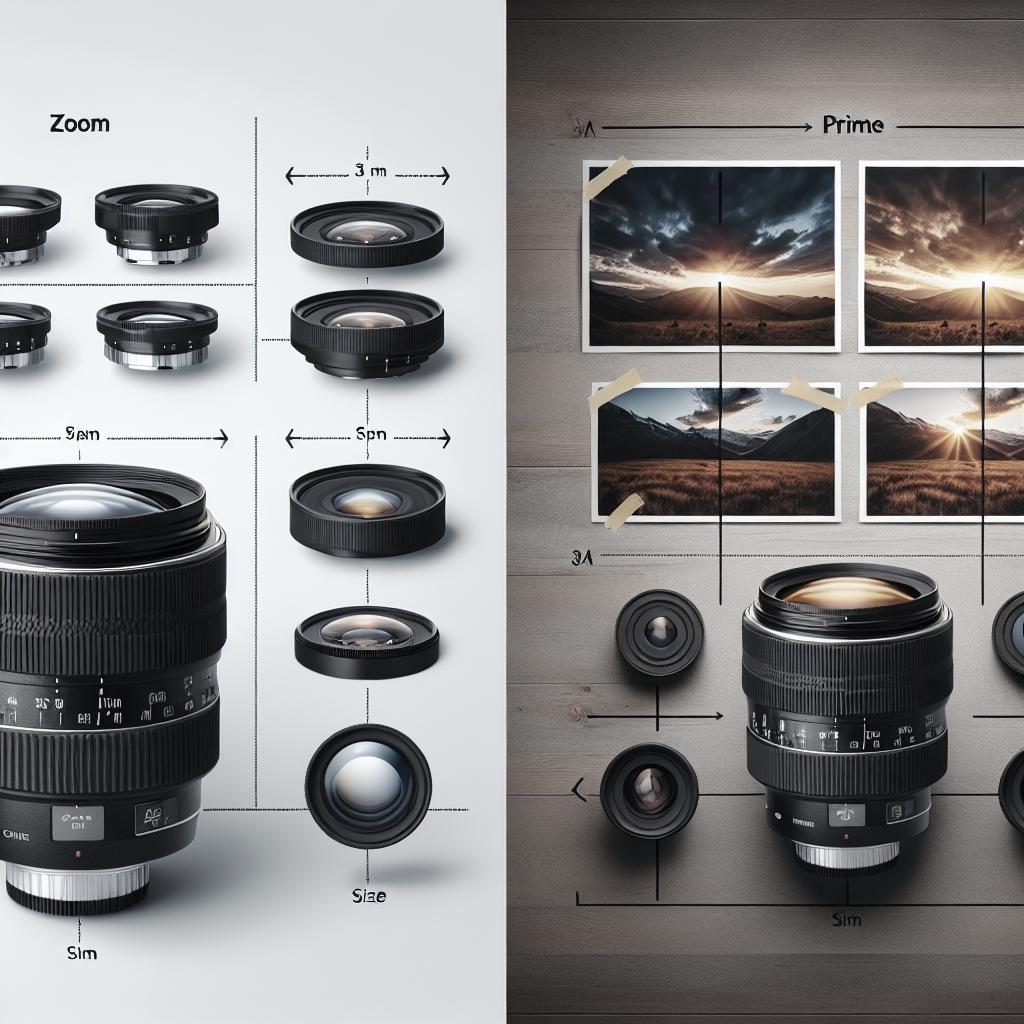“`html
The Essential Difference Between Zoom and Prime Lenses
In photography, choosing the right lens can transform your shots from mundane to magnificent. Photographers often debate between prime lenses and zoom lenses, each bringing unique strengths to the table. While prime lenses are known for their sharpness and low-light capabilities, zoom lenses offer remarkable versatility. In this blog post, we’ll explore the defining characteristics of both lens types, delve into their advantages, and help you decide the best option for your photographic needs.
Depending on Your Subject and Type of Photography, Each Has Its Uses
Photography is a highly subjective art form; therefore, the choice of equipment must align with the photographer’s vision and the subject’s nature. Depending on what you wish to capture, your lens selection can make all the difference. For portraits, landscapes, or action shots, the specialized nature of prime or zoom lenses can enhance the image. Understanding when to use each lens type is essential for capturing optimum results.
When shooting in a controlled environment where light is limited, prime lenses offer excellent capabilities due to their low aperture. On the other hand, if you are covering an event or taking candid shots, the zoom lens’s adaptability can save time and allow for various compositions without needing to switch lenses.
What is a Prime Lens?
A prime lens is a camera lens with a fixed focal length, meaning it does not zoom in or out. Common focal lengths for prime lenses range from wide-angle perspectives to more focused telephoto views. This limitation is seen as an advantage by many photographers, as it encourages movement and creativity in framing shots.
The structural simplicity of prime lenses often results in superior optical quality. With fewer moving parts, manufacturers can focus on optimizing the components for clarity, resulting in sharper images. This characteristic makes prime lenses particularly popular among portrait and landscape photographers who prioritize detail and resolution.
What is a Zoom Lens?
Zoom lenses are defined by their variable focal lengths, allowing photographers to shift from wide to narrow perspectives without changing the lens. This adaptability makes them a favorite among those needing to capture subjects at varying distances quickly and efficiently. Ranging from standard zooms to telephoto monsters, there’s a zoom lens for virtually every photographic situation.
In the intricate design of a zoom lens lies its strength. The ability to cover multiple focal lengths in a single lens setup empowers photographers to be ready for a myriad of scenarios. The convenience of zoom lenses cannot be overstated, especially for travel photographers who benefit from packing light without sacrificing creative flexibility.
Advantages of Prime Lenses
Cost
Generally, prime lenses are less expensive compared to their zoom counterparts of the same quality. The simplified design results in reduced manufacturing costs, which translates to affordable prices for consumers. Budget-conscious photographers can often acquire a higher quality prime lens than zooms at similar price points, making it a smart choice for beginners and professionals alike.
Size and Weight
Prime lenses are usually more compact and lighter than zoom lenses. This makes them convenient to carry, especially during travel or long photoshoots. The reduced size does not compromise the quality, allowing photographers to enjoy the benefit of exceptional image clarity without the burden of heavy gear.
Learning Factor
With a fixed focal length, a prime lens challenges photographers to move around more and rethink their composition. This requirement to physically adjust the position fosters improved skills and a deeper understanding of framing and subject interaction. For those looking to hone their photographic capabilities, a prime lens can be an effective teaching tool.
Creative Control with Faster Apertures
Prime lenses often come with faster apertures, allowing for better control over depth of field. This attribute provides more opportunities for creative effects like bokeh, which isolates the subject against a beautifully blurred background. Photographers can thus experiment more with artistic effects and stylistic elements in their shots.
Low Light
An area where prime lenses truly excel is low-light photography. Their broader aperture openings allow more light to enter the sensor, enabling shooting in dim conditions without escalating ISO settings, which could introduce noise. This ability makes them a go-to choice for nighttime photography, concerts, or dimly lit indoor environments.
Sharpness
Thanks to fewer glass elements and simplified construction, prime lenses generally provide sharper images than similar quality zoom lenses. This stark detail is advantageous in professional environments where sharpness is paramount, like portrait and product photography. As a result, many serious photographers include at least one prime lens in their kit.
Zoom Lens Advantages
Versatility
The hallmark of a zoom lens is its versatility. With a range of focal lengths in one product, photographers can adapt to various conditions and compose their shots fluidly. This adaptability is especially valuable in dynamic environments such as weddings or sports events, where the action unfolds unpredictably, and quick lens changes are impractical.
Image Stabilization
Many modern zoom lenses come equipped with image stabilization technology to counteract camera shake. This feature is an asset for handheld shooting, especially in low-light situations or when using extended focal lengths. By helping to secure steadier shots, it reduces the reliance on tripods, enhancing mobility and convenience.
Portability
While zoom lenses might be heavier than primes, having one versatile lens can reduce the need to carry multiple lenses. For photographers who cover a wide range of subjects, this can translate to fewer gear swaps and less equipment to lug around, ultimately enhancing one’s ability to maneuver and react quickly to changing conditions.
Prime Lens vs Zoom Lens: Which Should You Get?
The decision between a prime and zoom lens depends greatly on your specific photography needs. If top-notch image quality, low-light performance, and a shallow depth of field are critical, a prime lens is indispensable. It encourages you to refine your artistic vision through its limitations, proving excellent for learning and creativity.
On the flip side, if flexibility is a cornerstone of your shooting requirements, a zoom lens may be more versatile and cost-effective. For multi-genre photographers and those who want to travel light, the ability to seamlessly switch perspectives with minimal effort is invaluable.
Final Words
Whether you lean toward the simplicity of primes or the versatility of zooms, understanding the nuances of each lens type can unlock a new realm of photographic potential. As technology continues to evolve, both prime and zoom lenses will see advancements that enhance their unique qualities.
| Aspect | Prime Lenses | Zoom Lenses |
|---|---|---|
| Cost | Generally cheaper | More expensive, more versatile |
| Size and Weight | Smaller, lighter | Larger, heavier |
| Learning Factor | Encourages skill development | Offers convenience and adaptability |
| Creative Control | Excellent for depth of field and bokeh | Good for versatile compositions |
| Low Light | Superior performance | Good with image stabilization |
| Sharpness | Better sharpness | Slightly less sharp without high-quality build |
Related Articles
- The Best Photography Lenses for Beginners
- How to Maintain Your Camera Equipment
- Top Tips for Capturing Stunning Landscapes
“`


